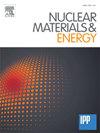下一步聚变实验的分离矩阵运行空间:从 ASDEX 升级数据到 SPARC 方案
IF 2.7
2区 物理与天体物理
Q1 NUCLEAR SCIENCE & TECHNOLOGY
引用次数: 0
摘要
核聚变发电厂需要无elm,分离运行,以防止导流器损坏和侵蚀。提出了分离矩阵操作空间(SepOS)作为识别进入i型无elm准连续排气区的工具。在这项工作中,我们使用简单的参数重新构建SepOS框架,并提供专用的ASDEX升级放电来演示如何解释其结果。通过分析由6688个单独测量数据组成的扩展ASDEX升级数据库,我们发现SepOS准确地描述了h模式边界如何随等离子体电流和磁场强度变化。然后,我们引入了标准化的SepOS框架和LH最小尺度,并证明了多个机器之间的标准化H-Mode边界几乎相同,这表明标准化的SepOS可以用于在不同机器之间转换结果。发现SepOS预测的LH最小密度与实验确定的多机器缩放密切匹配,这进一步间接验证了SepOS在多设备上的应用。最后,我们演示了如何使用SepOS进行预测,为SPARC确定一个可行的i型无ELM准连续排气(QCE)操作点,即ne,sep=4×1020m−3,Te,sep=156eV和αt=0.7,该值在ASDEX Upgrade上的QCE操作空间内。这演示了SepOS如何为下一步设备上的无elm操作提供简洁、直观的方法。本文章由计算机程序翻译,如有差异,请以英文原文为准。
The separatrix operational space of next-step fusion experiments: From ASDEX Upgrade data to SPARC scenarios
Fusion power plants require ELM-free, detached operation to prevent divertor damage and erosion. The separatrix operational space (SepOS) is proposed as a tool for identifying access to the type-I ELM-free quasi-continuous exhaust regime. In this work, we recast the SepOS framework using simple parameters and present dedicated ASDEX Upgrade discharges to demonstrate how to interpret its results. Analyzing an extended ASDEX Upgrade database consisting of 6688 individual measurements, we show that SepOS accurately describes how the H-mode boundary varies with plasma current and magnetic field strength. We then introduce a normalized SepOS framework and LH minimum scaling and show that normalized H-Mode boundaries across multiple machines are nearly identical, suggesting that the normalized SepOS can be used to translate results between different machines. The LH minimum density predicted by SepOS is found to closely match an experimentally determined multi-machine scaling, which provides a further indirect validation of SepOS across multiple devices. Finally, we demonstrate how SepOS can be used predictively, identifying a viable type-I ELM free Quasi-Continuous-Exhaust (QCE) operational point for SPARC, at , and — a value solidly within the QCE operational space on ASDEX Upgrade. This demonstrates how SepOS provides a concise, intuitive method for scoping ELM-free operation on next-step devices.
求助全文
通过发布文献求助,成功后即可免费获取论文全文。
去求助
来源期刊

Nuclear Materials and Energy
Materials Science-Materials Science (miscellaneous)
CiteScore
3.70
自引率
15.40%
发文量
175
审稿时长
20 weeks
期刊介绍:
The open-access journal Nuclear Materials and Energy is devoted to the growing field of research for material application in the production of nuclear energy. Nuclear Materials and Energy publishes original research articles of up to 6 pages in length.
 求助内容:
求助内容: 应助结果提醒方式:
应助结果提醒方式:


